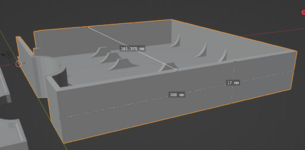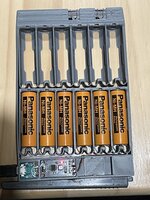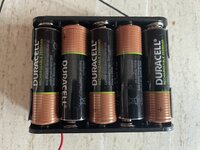luRaichu
Well-known member
Hi all,
I've been wanting to buy a PowerBook 1x0 for quite some time now. As of recently, I'm trying to figure out the best way for me to rebuild a battery for it. I've decided to go the route of utilising as many off-the-shelf parts as humanly possible, which means I'm going to use simple rechargeable AA's and a battery holder. Now, I want to stuff 10 AA cells inside a PB battery case, which has been talked about but barely done. With the bucketfulls of 2,500mAh rechargable Duracell AA's I proudly own, 10 cells would equal 25,000mAh which probably pales in comparison to whatever the original PB battery's capacity was (what was it actually?). From what I've seen nobody's made a 25,000mAh battery pack. Yet.
The biggest hurdle so far is the battery holder itself. There isn't a 10 AA holder for sale that is not wired series throughout and outputting the required ~6v. I've contacted a company called Memory Protection Devices that make these holders and after some slight social engineering/jedi mind trickery they'd like to custom manufacture the bespoke 10 AA/6v holder for me. They say they'll send me a free sample and give a quote for more.
Now, I could just use two 5 AA holders and wire them both in parallel, but my brain is small and idk how to go about that. But it's the most likely thing I'll do.
The most important part right now is trying to get measurements of the battery shell to see if a holder will even remotely fit in. I don't own a PB 1xx battery yet so I tried to measure some of the 3d-printed cases people've made [see attached image]. However these models import wonky into Blender and I don't think the measurements are accurate If anybody has a 1xx battery lying around I'd appreciate if you took out your calipers/ruler and measured the thing so I can compare with the size of a battery holder.
If anybody has a 1xx battery lying around I'd appreciate if you took out your calipers/ruler and measured the thing so I can compare with the size of a battery holder.
I've been wanting to buy a PowerBook 1x0 for quite some time now. As of recently, I'm trying to figure out the best way for me to rebuild a battery for it. I've decided to go the route of utilising as many off-the-shelf parts as humanly possible, which means I'm going to use simple rechargeable AA's and a battery holder. Now, I want to stuff 10 AA cells inside a PB battery case, which has been talked about but barely done. With the bucketfulls of 2,500mAh rechargable Duracell AA's I proudly own, 10 cells would equal 25,000mAh which probably pales in comparison to whatever the original PB battery's capacity was (what was it actually?). From what I've seen nobody's made a 25,000mAh battery pack. Yet.
The biggest hurdle so far is the battery holder itself. There isn't a 10 AA holder for sale that is not wired series throughout and outputting the required ~6v. I've contacted a company called Memory Protection Devices that make these holders and after some slight social engineering/jedi mind trickery they'd like to custom manufacture the bespoke 10 AA/6v holder for me. They say they'll send me a free sample and give a quote for more.
Now, I could just use two 5 AA holders and wire them both in parallel, but my brain is small and idk how to go about that. But it's the most likely thing I'll do.
The most important part right now is trying to get measurements of the battery shell to see if a holder will even remotely fit in. I don't own a PB 1xx battery yet so I tried to measure some of the 3d-printed cases people've made [see attached image]. However these models import wonky into Blender and I don't think the measurements are accurate







